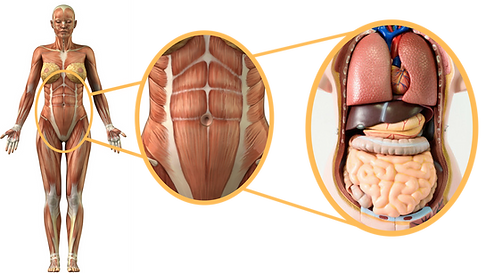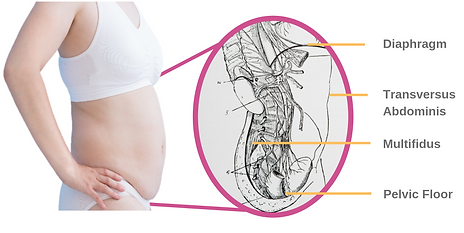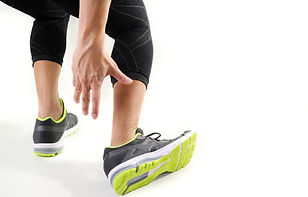YOUR CORE
The core is so much more than you might think.
Your core works around the clock to allow you to fully function in your day-to-day lives. When you lift your baby, your core is involved. When you cough, your core is involved. Even if you're simply sitting and reading this page, you're using your core.
When most people think of the core, they usually form an image in their minds that looks something like this:

The image often includes the rectus abdominis muscles (the 6 pack muscles), as well as the obliques (the muscles on the sides of the abdomen).
Very rarely do we think of the core as being an enclosed canister that contains fluid and houses the abdominal and pelvic organs. The core is also responsible for containing these organs and regulating intra-abdominal pressure (IAP), which rises and falls throughout the day, depending on the task at hand.
This pressure is the central mechanism from which our bodies gain physical strength and stability. The more challenging the task, the more IAP is produced. IAP not only keeps you sturdy in your centre, so that the rest of your body has a strong anchor from which to move, but also to keep the spine and the rib cage from collapsing.

The innermost muscles that are in direct contact with IAP are:
1. The Transversus Abdominis
2. The Diaphragm
3. The Pelvic Floor
4. The Multifidus
These muscles are in a great position to control IAP but are often left out of standard core training programs. In the post-partum period, the importance of these muscles cannot be understated. Without a strong and functional inner core, we lose the ability to keep our bodies sturdy during times of physical challenge.
If we zoom in even closer, we are able to appreciate the deep canister formed by inner core muscles:
.png)
Without knowing otherwise, many people return to traditional core exercises with hopes of getting their pre-baby body back. While these exercises may strengthen the larger, external core muscles, they tend to leave out the deeper muscles which need to be rehabilitated in a specific and coordinated manner.
Skipping rehabilitation for your deeper core and beginning your postpartum strengthening with planks and sit-ups is analogous to spraining your ankle and going for a run the next day.

So, before returning to high-level core strengthening exercises, spend time re-connecting to your inner core. After completing this step, simply re-integrate your deeper core muscles into your core exercise program.
%20(1).png)